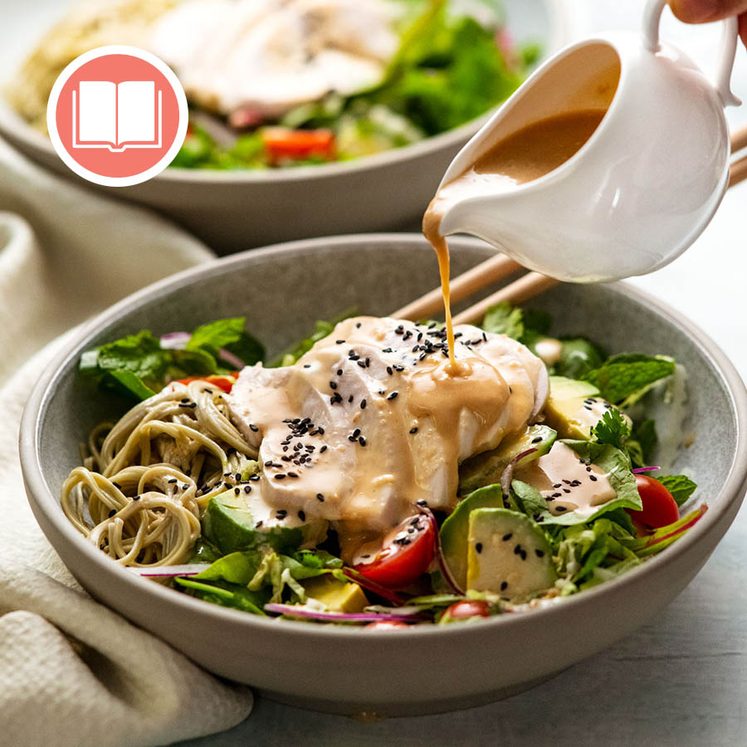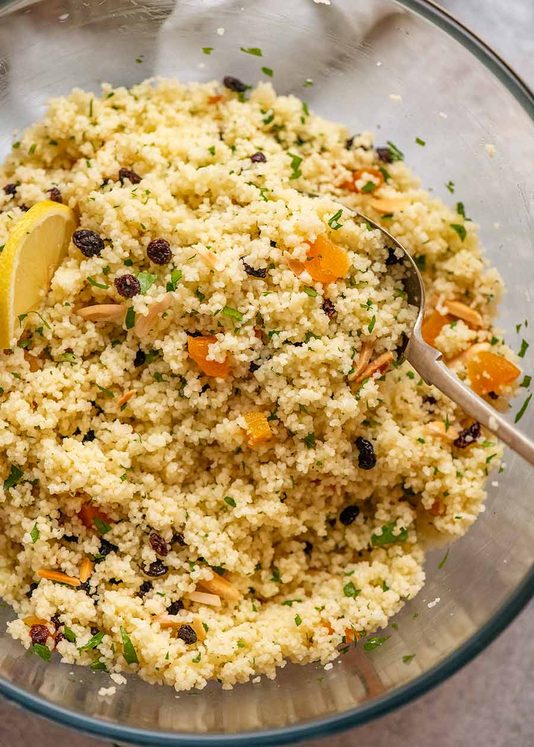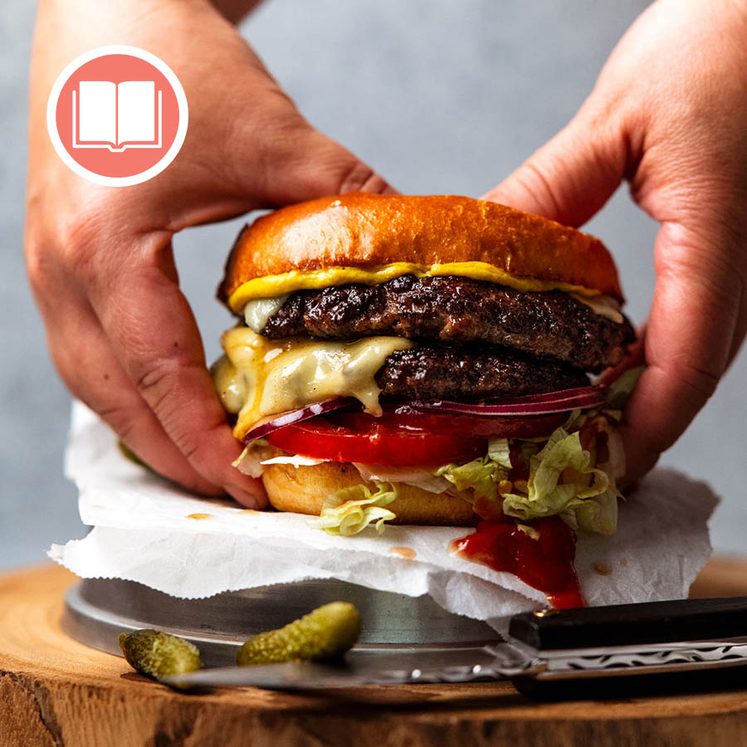This is the only chicken stock recipe you’ll ever need. It’s an excellent all-rounder that’s nice and clear, with the ideal balance of flavour, nutrients and richness. Use it for everything from clear soups to rich stews, gravies and creamy sauces.
I like making chicken stock because it’s easy compared to beef stock, and improves just about everything – the main goal here!
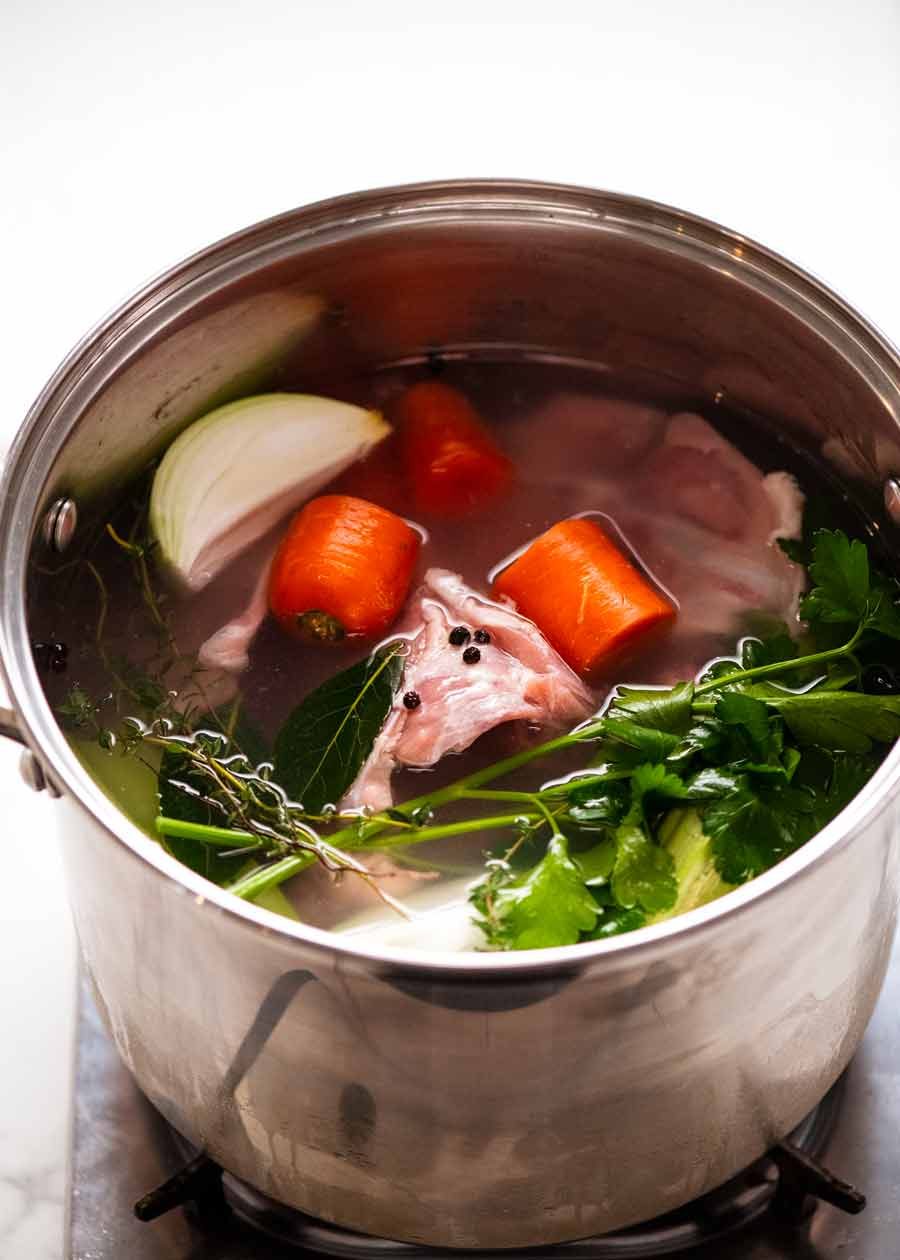
Chicken stock recipe
Stocks are the foundation for countless dishes in many cuisines. Chicken stock is one of the most common and versatile stocks in Western cooking, and is made by infusing water with the flavours of chicken, fresh root vegetables and herbs. Good restaurants always make their own stocks, and is the secret to why their dishes often have that richer, deeper, “restaurant-quality” taste to them!
If you’re not convinced why you’d bother making homemade chicken stock, let me persuade you:
-
Better flavour – Store-bought stock does not compare to real, freshly made stock. Just one taste is all you need to know this!
-
Richer mouthfeel – Homemade chicken stock has abundant gelatin from the chicken bones and tissues, which gives it a full-bodied richness and mouthfeel when used in soups and stews. Store-bought stock lacks this quality.
-
More versatile because it’s unsalted – Store-bought stock is almost always salted. This is fine when used at normal concentrations, but if stock is reduced a lot when making ragus, sauces and so on, the salt can become excessive – yet there is little you can do about it. Homemade stock on the other hand is unsalted, so you will never have this problem and can control seasoning in the finished dish.
-
Making jus and reductions – Fine dining reduction sauces such as jus rely heavily on the natural thickening power of gelatin to create that luscious, silky consistency. You can reduce a store-bought stock 90% on the other hand, and it will still be watery!
-
It’s surprisingly low-effort – While I’m the first to confess that beef stock does require commitment and lots of time to make (but it’s worth it!), chicken stock is much less maintenance. Just plonk everything in a pot and let it simmer for 3 hours, and strain!
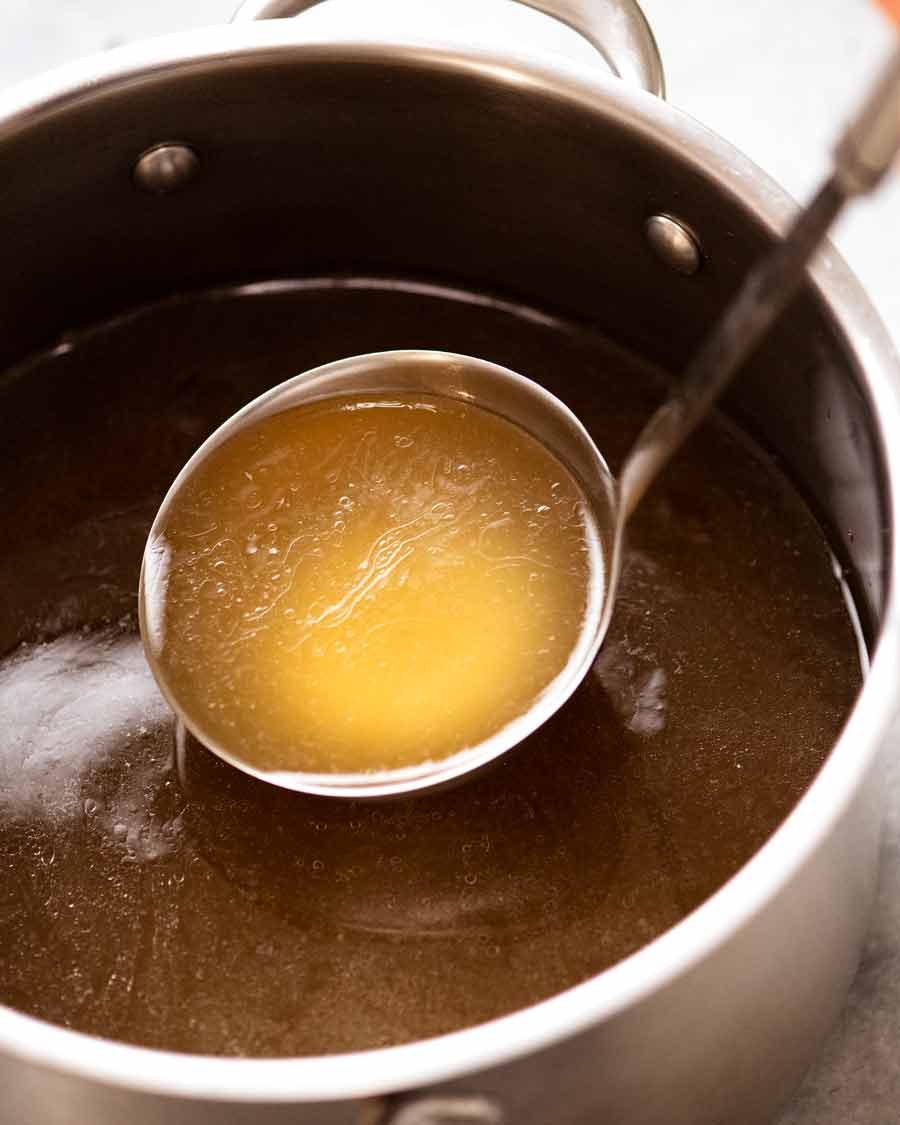
Bones for chicken stock
I use chicken bones to make chicken stock. I find that it makes a great all-rounder, clear stock with good flavour at store-bought strength. Specifically, I use chicken carcasses, also known as chicken frames, (see photo below) which litre for litre are the most economical cut.
What is a chicken carcass? A chicken carcass are the bones and cartilage “frame” of the chicken after all the meat has been cut off (breast, drumsticks, thighs, wings). There’s usually a decent amount of meat left on it, but it depends how nifty the butcher is with his knife skills! The balance of meat, bone and residual fat on a chicken carcass gives an excellent balance of flavour, valuable nutrients and collagen, as well as making a nice clear stock. They’re readily available here in Sydney from butchers and even grocery stores.
Some recipes will opt to use chicken pieces with meat and skin to make stock. I share my thoughts on this below! (Spoiler: I don’t agree!)
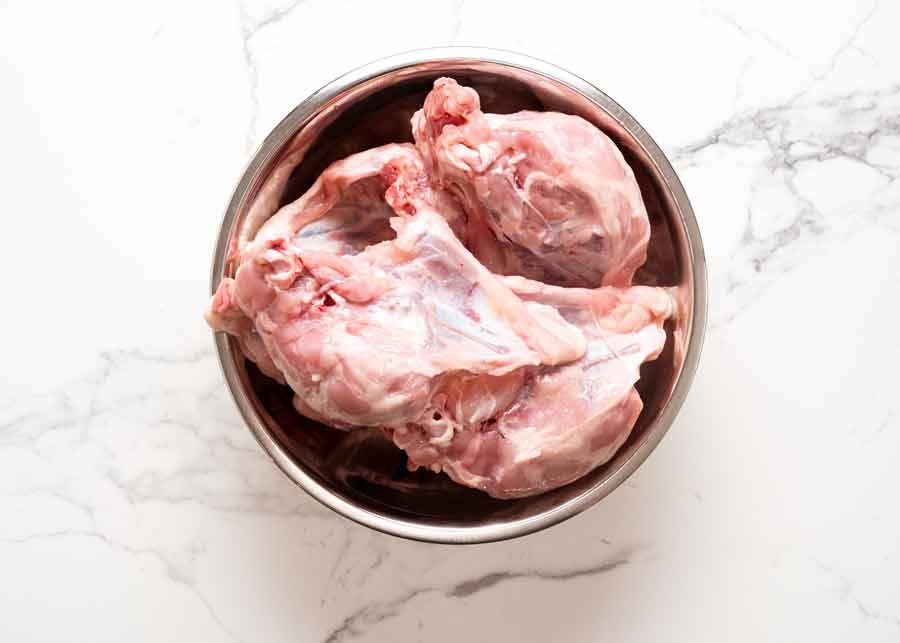
Why I don’t use other chicken cuts for stock
Here are my thoughts on other chicken cuts that are sometimes used for chicken stock:
-
Breast – I just think it’s wasteful. The cooked chicken is flavourless and stripped of all nutrition, because it’s given up all its goodness to the stock. So you can’t really use the spent meat for anything except maybe filler in strongly flavoured foods, or perhaps giving it to your dog! Also, because chicken breast is fairly neutral in flavour, you need a lot to extract enough flavour to make a decent stock.
-
Skin-on, bone-in chicken pieces, like thigh and drumsticks – While they make very flavourful stocks, the skin and fat makes the stock greasy and there will be quite a slick of oil floating on top of the stock. This is a little too fatty for many purposes, such as making nice clear chicken noodle soups.
-
Wing tips – Wing tips are packed with gelatin and flavour, being a dark meat. If you’ve got some, throw them in! But to make a whole batch of chicken stock, you’d need a LOT of wing tips.
-
Chicken feet – This will add a lot of gelatin into the stock so it wouldn’t hurt to throw some in (say 4 to 6) for extra richness. I think if you made a whole batch of stock using just feet it would be far too gelatinous!
-
Whole chicken – I find that you can’t extract enough flavour from a whole chicken for the amount of water required to cover it completely to make a proper flavourful stock. In fact, even when making a traditional chicken noodle soup using a whole chicken, I always add a small touch of stock powder to give the soup stock a little boost. Otherwise, it’s just a bit bland!
-
Giblets – Giblets refers to the heart, liver and gizzards of chicken that are sometimes bundled up and stuffed inside the cavity of store bought whole chicken. They are provided with the intention to make gravies and sauces. If you have some, by all means throw them in with the bones! I would not make a stock with just a big bag of giblets however, as it will be quite offal-ly!
-
Frame of cooked whole chicken – The carcass of a roast chicken will not provide enough flavour for homemade chicken stock. I’ve tried multiple times over the years! You just can’t get nearly enough flavour out of it for the amount of water required to cover it.
Vegetables and herbs for stock
Here are the other ingredients in homemade chicken stock:
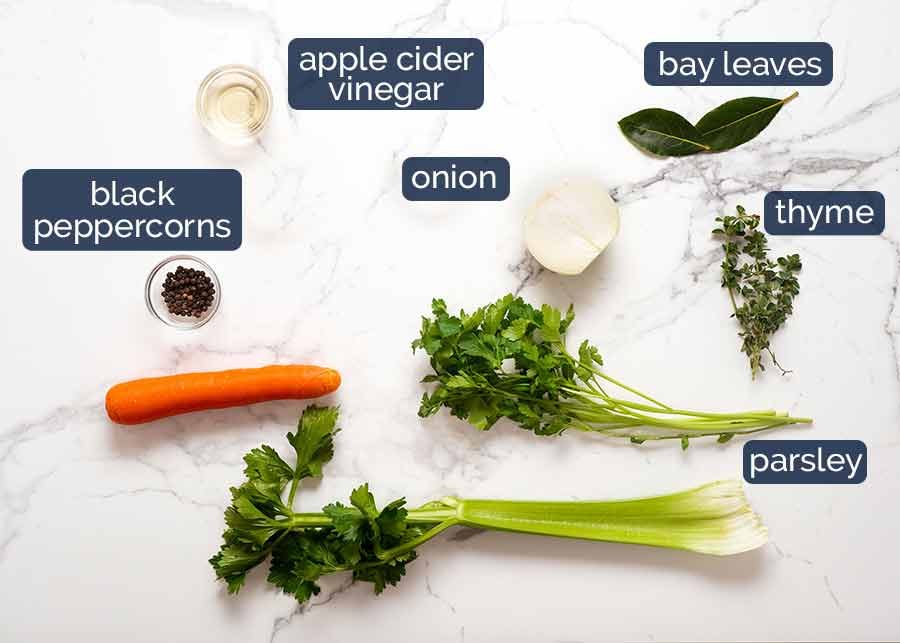
-
Bay leaves, thyme, parsley, black peppercorns – Herb and spice aromatics, a fairly standard selection for most stocks including beef stock and vegetable stock.
-
Onion, celery and carrot – Again, familiar building-block ingredients in most stocks and many Western dishes. The root vegetables add subtle sweetness as well as a freshness and complexity to the stock.
-
Cider vinegar – A little vinegar helps extract nutrients from the bone. We only use a splash, you cannot taste it nor does it make the stock discernibly sour at all.
Brown vs white chicken stock
A brown stock refers to a stock where the bones are roasted and the tray deglazed before simmering, as you would do with beef stock. A brown chicken stock has a deep, complex, roasted flavour as well as a darker colour.
A white chicken stock on the other hand simmers raw bones. The result is a cleaner, more neutrally flavoured and fresh-tasting stock that’s overall more versatile for cooking – versatile enough to be used even with seafood or non-chicken meat dishes, such as Fish Chowder. This is the type of stock that is mass produced and sold at grocery stores, and it’s the type of stock we are making today.
How to make chicken stock
Because we’re making a nice clear white chicken stock (see above), there’s no bone-roasting malarkey to take care of first which makes the whole process much quicker and less laborious. Just dump everything in a pot, add water and simmer!
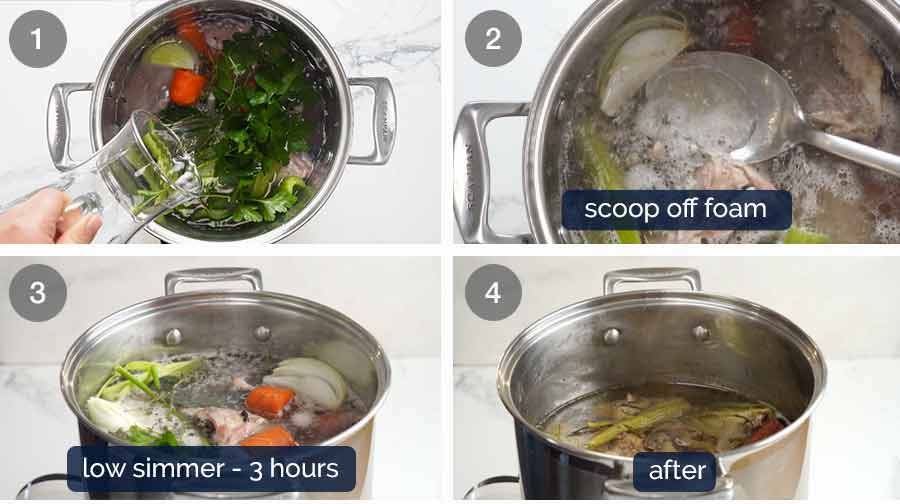
-
Put everything in a large stock pot –Place the chicken carcasses, vegetables, herbs and water in a large 7 litre /7 quart stock pot. 3 litres / 3 quarts of water should just about cover everything. If not, do a bit of pushing and poking to rearrange the carcasses and ingredients more snugly in the pot. Try not to break or crush the bones else this will make the stock murkier.
We want everything submerged so the water gets infused with flavour. Don’t worry if some of the bones are poking above the water surface. The carcasses will collapse once it starts cooking and end up under the water.
-
Scoop off scum – Bring the pot to a rapid simmer over medium-high heat. As it starts getting hot, you will see foam on the surface which is the impurities in the chicken. Scoop it off and discard to keep your stock nice and clear.
-
Simmer 3 hours – Once the water comes to a rapid simmer, lower the heat so it’s bubbling very gently. Then leave to simmer for 3 hours with the lid off.
-
After simmering – The photo above shows the water level after 3 hours. It has reduced by around 1/3.
Your chicken stock is done! Now we just need to strain it, remove excess fat (if you want) and store it! Here’s how:

-
Strain – Using the lid of the pot to hold back the bones and vegetables in the pot, strain the stock through a fine mesh strainer into another pot or large bowl. I use a pot in case I need to reduce it to the right amount (see below)..
If you’re not strong or comfortable with the lid method, just fish out the solids with tongs or a large straining spoon before pouring the remaining liquid through a sieve.
The goal: To end up with 2 litres / 2 quarts of chicken stock. In a perfect world, you will end up with2 litres / 2 quarts of chicken stock.But it is rarely a perfect world! And that’s ok. If you have less, than this just top up with water. If you ended up with more than about 2.25 litres / quarts, then reduce it on the stove, else you run the risk of a weak-flavoured chicken stock.
-
Leftover bones and vegetables – These have been well stripped of flavour and nutrition, so they aren’t really that useful. However, I do pick off excess meat for Dozer! But after that, I just discard the remnants.
-
Voila! Admire your beautiful and clear chicken stock!
-
Divide between storage containers – At this point, I divide the stock up into jars or containers which allows the stock to cool faster.
I store my chicken stock in 1 cup multiples which I find quite handy for use. Always label your containers with the quantity of chicken stock and date you made it!

-
Cool then refrigerate – Once the stock is cooled to room temperature, place them in the fridge to fully cool. Never put hot stock in the fridge!
-
Solidified fat – As the stock cools, the fat will rise to the surface. Once fully cold, the fat solidifies and turns into a white sheet of solid fat on the surface of the stock, like a frozen-over lake.
You will also notice that the chicken stock firms up into a jelly-like consistency when cold. This is due to the gelatin. We want gelatin – it’s what gives the stock a delicious, lip-sticking, rich mouthfeel you don’t get in store-bought stock (ever notice how store-bought stock never sets like this in the fridge?) So basically, jelly consistency = good stock!
-
Scrape off fat – Scrape the fat off the surface using a spoon and discard. This is actually an optional step. It makes the stock light and clean, making it a great all-rounder that can be used for everything from clear soups (like Chinese Noodle Soup) to rich sauces (like the sauce of a Creamy Chicken Pasta). For a jus or reduction sauces you should also use de-greased stock.
But if you are intending to use the stock for things like stews (like this one) and creamy sauces (like Mushroom Sauce) that do not require a clear, de-greased chicken stock like we desire for things like Chicken Noodle Soup, then there is no need to remove the fat.
-
Storing – Homemade stock will keep for 5 days in the fridge or for 6 months in the freezer.
Fridge-cold chicken stock can be used as is, in its jelly-like state. It melts back into liquid form very quickly as soon as it’s heated.
If using from frozen, thaw overnight in the fridge, microwave, or run the container under hot water to loosen, then melt in a saucepan. Though if I’m adding the stock into an already-simmering liquid sometimes I’ll just add the frozen stock block as-is! It melts fairly fast and the result is the same. I use all of these methods depending on how much time I have!
Here’s a jar of refrigerated chicken stock which has had the fat scraped off the surface.
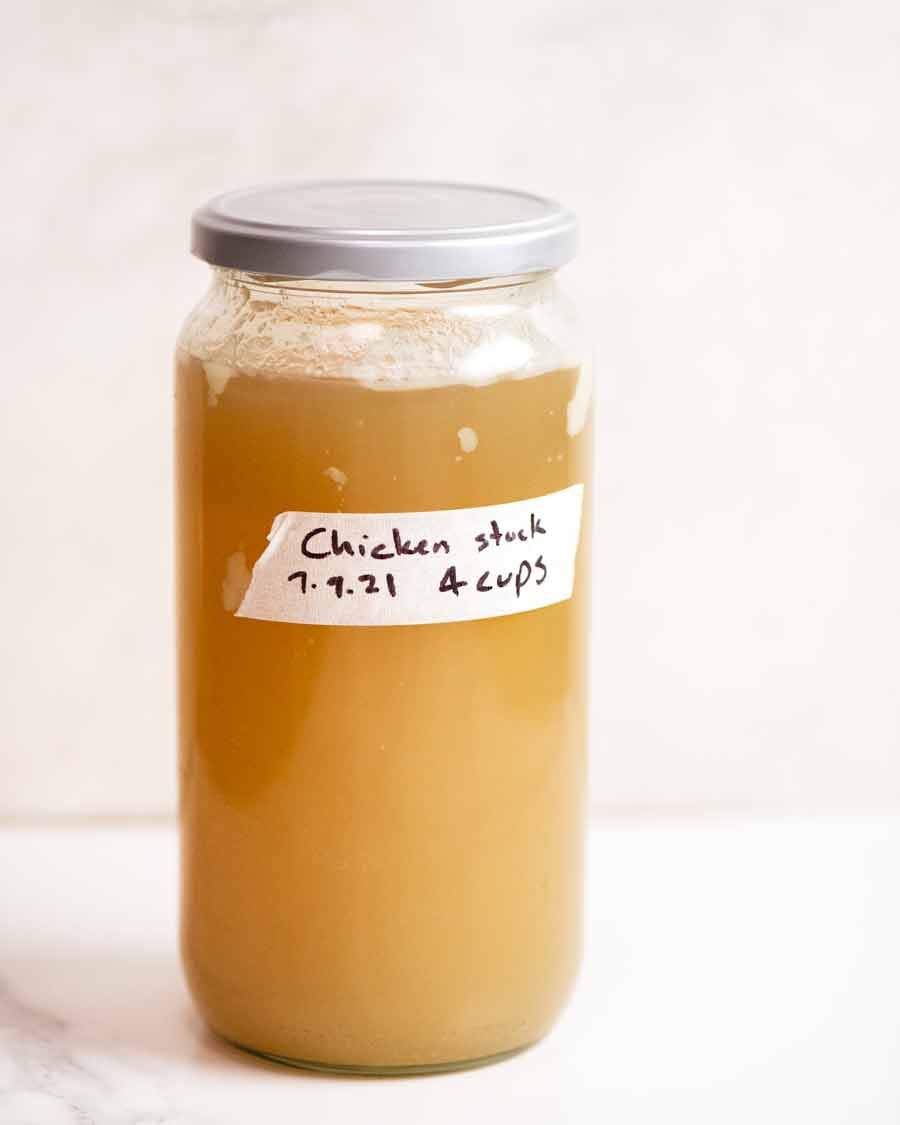
And here it is in liquid form at room temperature. But as noted above, you can just use chicken stock in jelly form as it melts in seconds on contact with heat!
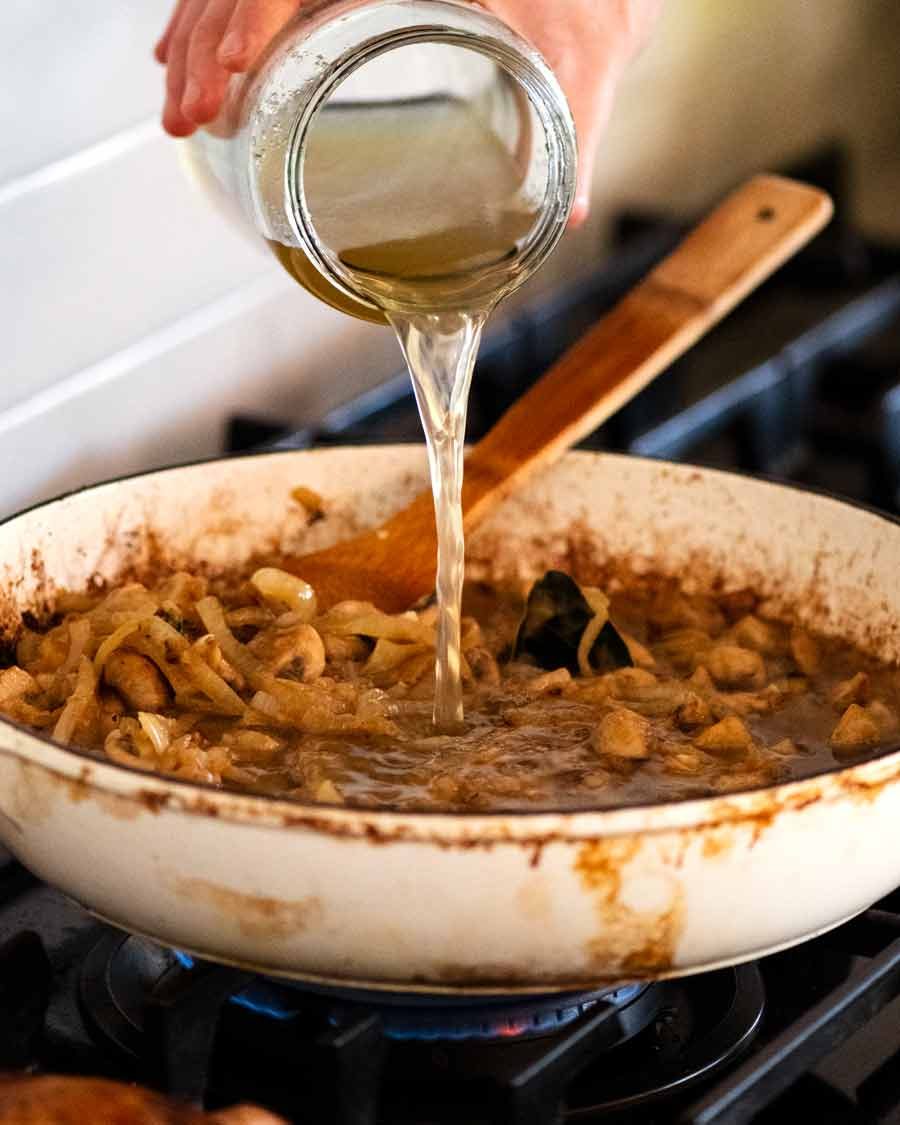
What to do with homemade chicken stock
This homemade chicken stock can be used for any recipe that calls for chicken stock. It will elevate any dish from great homemade food to top-notch, restaurant-quality in taste, believe me!
Homemade stock particularly makes a difference in dishes where the quality and flavour of the stock can shine. In other words, dishes that are not heavily flavoured with spices, seasonings or a heavy dose of cheese! Some ideas:
-
Rice dishes – Rice is a sponge for all that delicious stock in Mushroom Rice, Paella, Jambalaya and Oven-baked Chicken and Rice.
-
Clear soups – The pure flavour of the stock shines in Chicken Noodle Soup, Wonton Soup or Chinese Noodle Soup
-
Vegetable soups – It also gives real depth to simple vegetable soups, like Mushroom Soup, Minestrone, Pumpkin Soup, Leek and Potato Soup.
-
Stews and braises – Homemade stock raises any stew to restaurant-quality levels! Chicken is an obvious choice: Say Chicken Pot Pie, Chicken Tetrazzini or Chicken Stew with chicken stock. But chicken stock can equally carry other meats in a braise – Fish Chowder Soup or even Beef Bourguignon. And I actually deliberately use chicken stock over beef stock for Irish Guinness Stew, for better flavour.
-
Sauces and gravies – A world apart when made with homemade stock, whether it’s Turkey Gravy, Quick Gravy or a complete pan bake like Sausages with Potatoes and Gravy. Meanwhile a proper jus needs a proper stock, and this amazing Vermouth Jus can be made with chicken instead of beef stock.
On Wednesday, I’m going to be sharing a recipe that really benefits from homemade chicken stock. It’s great made with store bought, but when made with homemade, it takes it to company-worthy! – Nagi x
Watch how to make it
Hungry for more? Subscribe to my newsletter and follow along on Facebook, Pinterest and Instagram for all of the latest updates.
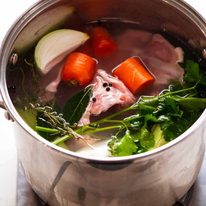
Chicken stock recipe
#wprm-recipe-rating-0 .wprm-rating-star.wprm-rating-star-full svg * { fill: #343434; }#wprm-recipe-rating-0 .wprm-rating-star.wprm-rating-star-33 svg * { fill: url(#wprm-recipe-rating-0-33); }#wprm-recipe-rating-0 .wprm-rating-star.wprm-rating-star-50 svg * { fill: url(#wprm-recipe-rating-0-50); }#wprm-recipe-rating-0 .wprm-rating-star.wprm-rating-star-66 svg * { fill: url(#wprm-recipe-rating-0-66); }linearGradient#wprm-recipe-rating-0-33 stop { stop-color: #343434; }linearGradient#wprm-recipe-rating-0-50 stop { stop-color: #343434; }linearGradient#wprm-recipe-rating-0-66 stop { stop-color: #343434; }
Ingredients
- 2 kg/ 4 lbchicken frames (ie carcass), raw (Note 1)
- 1carrot(medium), unpeeled, cut into 4 equal pieces
- 1/2onion, peeled and halved
- 1celery stem, cut in four (use the leaves too)
- 1/2tbspblack peppercorns
- 1tbspapple cider vinegar(Note 2)
- 2bay leaves, fresh (or 1 dried)
- 2thyme sprigs(or 1/2 tsp dried leaves)
- 3parsley sprigs
- 3 litres / 3 quartswater(just tap water, cold)
Instructions
How to make chicken stock:
-
Fill pot: Place all the chicken stock ingredients into a large stockpot (7 litre / 7 quarts+). Fill with 3 litres / 3 quarts of cold water, which should just about cover the bones. (Note 3)
-
Scoop off scum: Bring to a boil on medium-high heat. Scoop off and discard any foam that collects on the surface using a ladle (this helps make stock clear).
-
Simmer 3 hours: Turn stove down to low and simmer for 3 hours with no lid. The stove should be low enough so the surface is barely rippling and you just get a gentle bubble every now and then. Too rapid boiling = murky stock.
-
Strain: Using a lid to hold the bones and vegetables in the pot, pour the stock through a fine sieve into another pot or large bowl. (Alternatively, scoop out the solids first with a slotted spoon and then strain.)
-
Goal: You should end up with 2 litres / 2 quarts of stock. If you have more than about 2.25 litres / quarts, reduce by simmering on low (else the stock will be too weak). If you have less than 2 litres / quarts, top up with water.
-
Fill jars/containers: Measure out into containers for storage and faster cooling. (I do multiples of 1 cup)
-
Cool: Allow to cool on the counter then refrigerate. This will make any fat rise to surface and solidify.
-
Discard fat: Scrape fat off the surface and discard.
Storing and using:
-
Ready to use! This stock is equivalent in strength to store-bought stock, so it can be used 1:1 in any recipe calling for chicken stock.
-
Store for 5 days in the fridge or freezer for 6 months. (Note 6)
-
Salt adjustment (Note 5): Homemade stock is unsalted whereas store-bought stock is salted. Add 1/4 tsp salt for every 1 cup homemade chicken stock (250ml) to match the salt level of store-bought low sodium chicken stock.
-
To use: Cold stock has a jellied consistency (Note 4). It takes barely a minute to turn liquid on a medium-high stove, or microwave. You can also just add it in jelly form straight into dishes, but sometimes you may need to liquify it to measure.
Recipe Notes:
- the proportions of meat, bone and residual fat gives an excellent balance of flavour, valuable nutrients and collagen
- it makes a nice clear stock that is an ideal “all rounder”.
Other chicken cuts can be used but yields stock with different characteristics eg. skin-on bone-in chicken pieces (thighs, drumsticks) will be fattier and murkier. See in post for more information.Carcass of roasted chicken after removing the cooked meat not recommended – does not yield enough flavour. 2. Cider vinegar – Helps extract nutrients out of the bones. You cannot taste it nor does it make the stock sour.3. Fitting in pot – Arrange the bones and vegetables so they fit snugly, but don’t crush / break the bones as this will tend to make the stock murky. The water should just about cover the bones. Don’t worry if they are sticking out a bit, they will collapse as they cook.4. Stock consistency – When cold it will turn to a soft jelly like due to gelatin. Gelatin gives the stock richness that you don’t get in liquid store-bought stock. Gelatin is good! So, jelly is good : )5. Salting – Homemade stock is not salted, so it can be massively reduced to make things like jus without becoming too salty. You cannot make fine sauces like jus using store bought stock. Note however that homemade chicken stock has a small amount of natural salt. If you reduce it by say 90% or more, you will begin to taste it. Think of it as natural seasoning!6. Storing – Homemade stock will keep for 5 days in the fridge or for 6 months in the freezer.Fridge stored: When fridge-cold, it becomes gelatinous (jelly-like) from the collagen in the bones. This is good! It means it’s rich with gelatin, which gives the dishes we use it in a luscious, lip-sticking quality. It’s fine to use as a jellied stock, it will immediately melt back to liquid when heated.Frozen: Either thaw overnight in the fridge, microwave, or run the container under hot water to loosen then melt in a saucepan. Sometimes if I’m adding the stock to a simmering liquid I’ll just throw it in frozen! It melts quite quickly and the end result is the same. I use all methods depending on how much time I have!
Nutrition Information:
Life of Dozer
He really believes in his heart that I made that mini strawberry cream cake just for him…..


